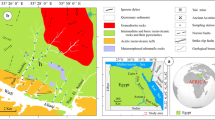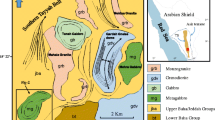Abstract
Platinum has been one of the highly needed mineral resources in China. The geochemical exploration at two survey scales was applied in telescoping ore targets for the first time in Eastern Yunnan Pt geochemical province that was delineated using Pt data from flood plain sediments with extra-low sampling density. Our study was based on the delineations and assessments of both regional and local Pt anomalies using the Pt data by analyzing with C-OES the composite samples with two sampling densities. The composite samples were obtained by recomposing at two sampling densities the original stream sediment samples collected by the National Geochemical Mapping Project. Semi-variograms were used to quantitatively describe the variability of Pt anomalies and further analyze the factors controlling the variability. Pt resource potentials of both the regional Pt anomalies and the local Pt anomalies in the study area were estimated based on the geochemical block methods, respectively. It comes to the conclusions as follows. (1) From the regional to local Pt anomaly, the factors controlling their variability from the deep seated faults-basalts turn into the basalts-branch faults, which suggest that Semi-variograms could identify the geological factors controlling the variability of the Pt anomalies identified by the Pt data from the stream sediments with different sampling densities. (2) There exist two types of Pt anomalies in the study area. One is those displaying at sampling densities, and its average Pt concentration significantly increases with sampling density increasing. The other is getting weaker and/or disappears with sampling density increasing. This shows that TOTGEMS could gradually eliminate non-ore anomalies and keep ore anomalies. (3) The average Pt concentration of the local Pt anomaly blocks delineated using Pt data from stream sediments with sampling density of one composite per 16 km2 is twice as much as that of the regional Pt anomaly blocks delineated using Pt data from stream sediments with sampling density of one composite per 64 km2. The Pt resource amount of the local Pt anomaly blocks is 60% of the regional anomaly blocks, but the area of the former is just 35% of the latter, which suggests that the Pt resource amount is mainly concentrated in its local anomalies, and that TOTGEMS has a good exploration function that efficiently approaches ore targets.
Similar content being viewed by others
References
Burenkov E K, Golovin A A, Morozova I A. Multi-purpose geochemical mapping (1:1000000) as basis for the integrated assessment of natural resources and ecological problems. J Geochem Explor, 1999, 66(1–2): 159–172
Xie X J, Cheng H X. Global geochemical mapping and its implementation in the Asia-Pacific region. Appl Geochem, 2001, 16: 1309–1321
Cohen D R, Kelley D L, Anand R. Major advances in exploration geochemistry, 1999–2007. In: Milkereit B, ed. Exploration in the New Millennium: Proceedings of the Fifth Decennial International Conference on Mineral Exploration, Toronto. Decennial Mineral Exploration Conference, Toronto, 2007. 3–18
Wang M Q, Gao Y Y, Liu Y H. Progress in the collection of Geogas in China. Geochem: Explor Environ Anal, 2008, 8(1): 183–190
Wang X Q, Xie X J. Delineation of regional geochemical anomalies penetrating through thick cover in concealed terrains: Case history from the Olympic dam deposit, Australia. J Geochem Explor, 1999, 66(1–2): 85–97
Xie X J, Wang X Q. Orientation study of strategic deep penetration geochemical methods in the central Kyzylkum desert terrain, Uzbekistan. J Geochem Explor, 1999, 66(1–2): 135–143
Xie X J, Liu D W, Xiang Y C. Geochemical blocks for predicting large ore deposits-Concept and methodology. J Geochem Explor, 2004, 84: 77–91
Wang X Q, Shen W J, Zhang B M, et al. Relationship of geochemical blocks and ore districts: examples from Eastern Tianshan metallogenic belt, Xinjiang, China (in Chinese). Earth Sci Front, 2007, 14(5): 116–123
Xie X J. New strategy for mineral exploration (in Chinese). Geophys Geochem Explor, 1997, 21(6): 402–410
Cheng H X, Shen X C, Xie X J. Wide-spaced floodplain sediment sampling covering the whole of China: pilot survey for international geochemical mapping. In: Xie X J, ed. Proceedings of the 30th International Geological Congress. Vol.19: Geochemistry. 1997. 89–109
Chen Y Q, Xia Q L, Liu H G. Geochemical characteristics of Pt-Pd-Cu ore-bearing formations in eastern Yunnan and analysis of their ore potentiality (in Chinese). China Geol, 2003, 30(3): 225–234
Mao J W, Cheng Y B, Guo C L, et al. Gejiu tin polymetallic ore-field: Deposit model and discussion for several points concerned (in Chinese). Acta Geol Sin, 2008, 82(11): 1455–1467
Zhu B Q, Chang X Y, Qiu H N, et al. Middle Proterozoic characteristics and ore forming possibility of supper large deposits of middle Yunnan Province in western margin of Yangtze platform (in Chinese). In: Tu G Z, et al, eds. Supperlarge Deposits in China (I). Beijing: Science Press, 2000. 95–116
Fan D L, Zhang T, Ye J, et al. Supperlarge deposits related to balck shale (in Chinese). In: Tu G Z, et al, eds. Supperlarge Deposits in China (I). Beijing: Science Press, 2000. 204–219
Fan D L, Zhang T, Ye J, et al. Black Shale Series and Related to Ore Deposits of China (in Chinese). Beijing: Science Press, 2004. 1–449
Xiong D X, Sun X M, Shi G Y. Geochemistry and Metallogenic Model of Ailaoshan Cenozoic Orogenic Gold Belt in Yunnan Province, China (in Chinese). Beijing: Geological Publishing House, 2007. 1–190
Tao Y, Hu R Z, Wang X Z, et al. The Cu-Ni-PGE mineralization in the Emeishan large igneous province-geochemical study on some typical deposits (in Chinese). Bull Miner Petrol Geochem, 2006, 25(3): 236–244
Zhang C J, Li X L. Geochemical characteristics of platinum group elements in Emeishan basalts. Acta Petrol Sin, 1998, 14(3): 299–304
Coveney R M, Nansheng C. Ni-Mo-PGE-Au-rich ores in Chinese black shales and speculations on possible analogues in the United States. Miner Deposita, 1991, 26: 83–88
Coveney R M, Murowchick J B, Grauch R I, et al. Field relation, origins, and resource implications for platiniferous molybdenum-nickel ores in black shales of South China. Explor Mining Geol, 1992, 1(1): 21–28
Wang M, Sun X M. Geology, Geochemistry and Genesis of PGE-polymetallic Deposits in the Black Rock Series, Southern China (in Chinese). Beijing: Geological Publishing House, 2007. 1–136
Wang D H, Luo Y N, Qu W J, et al. Geology, Geochemistry and Exploration of PGE Deposits in SW China (in Chinese). Beijing: Geological Publishing House, 2007. 1–335
Chen Y Q, Xia Q L, Liu H G. Study on assessment of precious metals resources associated with black shales (in Chinese). Progr Geophys, 2003, (2): 261–268
Starostin V I, Yapaskurt Q V. Au-Cu black shale formations. Earth Sci Front, 2007, 14(6): 245–256
Xie X J, Mu X Z, Ren T X. Geochemical mapping in China. J Geochem Explor, 1997, 60: 99–113
Zhao P. Determination of ultra-trace gold, platinum and palladium in geochemical exploration sample by emisson spectrometry with foam absorbent (in Chinese). Spectrosc Spectr Analysis, 2001, 21(2): 235–236
Zhang H, Liu H Y, Chen F L. Regional geochemical exploration for platinum and palladium (in Chinese). Geochem, 2002, 31(1): 55–65
Johnston K, Ver Hoef J M, Krivoruchko K, et al. Using ArcGIS Geostatistical Analyst. New York: Earth Sciences Research Institute, 2001. 1–300
Agterberg F. New applications of the model of de Wijs in regional geochemistry. Math Geol, 2007, 39(1): 1–25
Cheng Q M. Singular mineralization processes and mineral resources quantitative prediction: New theories and methods (in Chinese). Earth Sci Front, 2007, 14(5): 42–53
Yan M C, Chi Q H. The Chemical Compositions of the Continental Crust and Rocks in the Eastern Part of China. Beijing: Science Press, 2005. 1–171
Deutsch C V, Journel A G. GSLIB: Geostatistical Software Library and User’s Guide. Oxford: Oxford University Press, 1998. 1–369
Wang R D, Hu G D. Linear Geostatistics (in Chinese). Beijing: Geological Publishing House, 1988. 1–260
Pan G C. Introduction to fundamental geostatistical techniques for resources estimation. Short Course Presented for Chinese Academy of Geosciences, Beijing. 2001. 1–77
Doe B R. Source rocks and the genesis of metallic mineral deposits. Global Tecton Metallog, 1991, 4: 13–19
Keays R R, Scott R B. Precious metals in ocean-ridge basalts: Implications for basalts as source rocks for gold mineralization. Econ Geol, 1976, 71(4): 705–720
Sharara N A, Wilson G C, Rucklidge J C. Platinum-group elements and gold in Cu-Ni-mineralized peridotite at Gabbro Akarem, Eastern desert, Egypt. Can Mineral, 1999, 37(5): 1081–1097
Lai Y W, Gan S C, Qi C M, et al. Analysis of platinum and palladium occurrence states in Emei basalt (in Chinese). Rock and Miner Anal, 2003, 22(2): 121–123
Zhang X Y, Luo Y N. Yang C X. Panzhihua-Xichang Rift in China (in Chinese). Beijing: Geological Publishing House, 1988. 1–325
Zhang S Y, Pan Y L. Principles of Applied Geophysics (in Chinese). Wuhan: China University of Geosciences Press, 1988. 1–325
Author information
Authors and Affiliations
Corresponding author
Additional information
Supported by National High-Tech Research & Development Program of China (863 Program) (Grant No. 2006AA06Z113) and National Natural Science Foundation of China (Grant No. 40772197)
Rights and permissions
About this article
Cite this article
Chen, Y., Huang, J., Zhai, X. et al. Telescoping ore targets by geochemical exploration at multiple scales in Eastern Yunnan Pt geochemical province, southwestern China. Sci. China Ser. D-Earth Sci. 52, 627–637 (2009). https://doi.org/10.1007/s11430-009-0051-x
Received:
Accepted:
Published:
Issue Date:
DOI: https://doi.org/10.1007/s11430-009-0051-x




